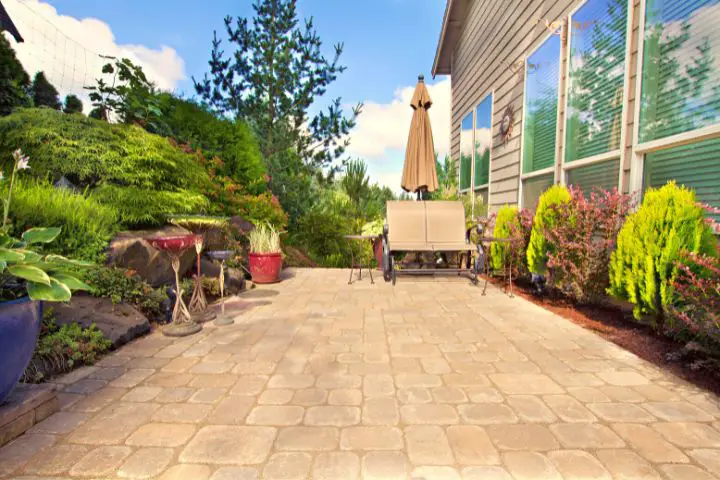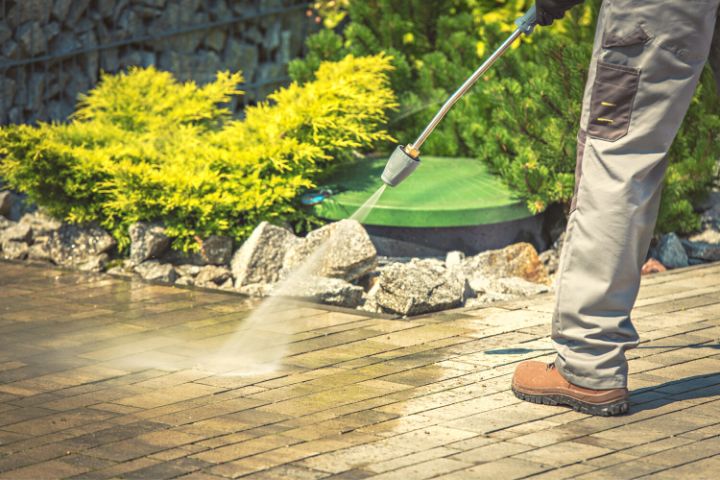How to Stop Weeds Growing Between Pavers | + How to Remove Them!
I love the look of pavers for a cozy outdoor patio, but keeping them clean and tidy is… boring! To put it politely!
In the never ending to-do list of things to do around the house, clearing up weeds that grow outside is one of my most hated chores!
You have to remove existing weeds and stop their growth, otherwise, your pavers may be loosened, causing an unnecessary cost! In this article, I will tell you about the different ways to remove weeds and how to stunt their growth to keep your pavers clean and pretty!
Related Article: How To Get Rid Of Moss On Pavers and How to Remove Stains From Pavers
Can I Pull the Weeds Out Myself?
We know that grass can grow through sand, so nothing stops weeds from growing in between your pavers!
You can always get down and dirty and take the weeds out manually. However, de-weeding your pavers isn’t as easy as de-weeding your garden. Plus, it takes forever to do and doesn’t guarantee 100% success.
There’s a chance that you left the root of the weeds in, which will make them grow wildly again. Luckily, there are natural, inexpensive ways to get rid of weeds.

How to Kill Weeds Between Pavers Naturally
I’m all for natural solutions; surprisingly enough, the things you find in the kitchen are as effective as a chemical weed killer!
However, I will also list the chemical options as well if the weeds have completely taken over your pavers.
Solution One: Vinegar Mixture
Vinegar has a high acetic acid content, making it a super effective weed killer. However, you can’t use apple cider vinegar or just any vinegar for this! You have to make sure that the vinegar has 5% acetic acid, which is white distilled vinegar.
The acid will reduce moisture from the weeds, causing them to shrink and die. This process usually happens within 24 hours, so vinegar is the way to go if you’re looking for a quick fix. You must use the vinegar without diluting it for the best results.
During the middle of the day (when it is hottest), spray the vinegar on the leaves and roots of the weeds. Combining some salt and dishwashing liquid can bump up its effectiveness, with noticeable results within an hour.
Avoid spraying the solution on your other plants as it can kill them too. Repeat as necessary every 2 days.
Solution Two: Baking Soda
Baking soda has a very high salt content, making it another effective weed killer. They will also dry out the leaves and roots, eventually killing the weeds. Spray some water over the weeds in the pavers and sprinkle a good amount of baking soda on top of them.
This method is also good for preventing weeds in your pavers. It’s best done during the seasons of autumn and spring.
Solution Three: Salt

Salt is actually a classic herbicide if you didn’t know!
Like baking soda and vinegar, salt draws out the moisture from weeds, leaving them dry and unable to survive. Mix 1 part salt with 3 parts water to create a saltwater solution. Spray this solution on the weeds and wait for it to work its magic.
Once you’re done with the weeds, cover the area with some dry salt. Do this every 2 to 4 weeks when it’s not windy.
Solution Four: Boiling Water
Caution, hot!
Boiling water can kill weeds and prevent the germination of seeds that may be in between the pavers. Fill up a pot or jug of hot water and pour it between the paver joints where the weeds grow.
Repeat this 3 times to get the best results. Use gloves to carry the pot or jug outside, so you don’t burn your hands. You can use this method as often as you like, however, it’s not effective enough for big weeds.
Solution Five: Pressure Washing
After pulling the weeds out by hand, you can use the pressure cleaner to get the roots out of the pavers. Pluck out the largest weeds by hand, then proceed with the pressure cleaner. When using the pressure cleaner, try not to get too close to the paving sand, as you may loosen the paving stones.

Solution Six: Chemical Treatments
If nothing has worked, chemical treatments are still available! Last resort!
There are two types of chemical treatments: pre-emergent and post-emergent. Post-emergent treatments work on growing weeds, while pre-emergent treatment works on preventing the germination of seeds.
Post-emergent treatments come in selective and non-selective options. Selective herbicides are put on your pavers as they only target the weeds, so they do not affect your surrounding grass or plants. Non-selective will affect all plants, so you should only use them on the weeds only.
How Do I Prevent the Growth of Weed in My Pavers?
While regular paver maintenance is necessary, there are ways to prevent the growth of weeds in the pavers altogether.
Here are some pointers to stop weeds from growing between the pavers:
- You should regularly use the pressure cleaner to take out the seeds and roots from the pavers that may be hiding. Point the jet washer directly in the cracks and hold for about 20 seconds. Any longer, and you may loosen your paving stones.
- Sweep your pavers regularly as well. I know you’re asking how does sweeping help if weeds come from underneath the sand? Actually, this is a misconception, as weeds grow from dispersed seeds that are carried by the wind. When you sweep, you disturb the seeds, so they do not have a chance to grow.
- After pressure cleaning your pavers, you should use a joint stabilizing sealer to prevent weeds from growing. Spray it on the paver; the sand will absorb it, making it hard and resistant to rain and wind. This makes it unbearable for weeds to grow.
- Ensure you have a proper slope. Since weeds thrive in damp soil, it’s important to make sure that your paving is slightly sloped, so water does not stand in one place.

I advise you to use polymeric sand in between your pavers as it prevents weed growth and reduces the number of bugs that can wander into your home. Polymeric sand is also easy to put in too!
You should pressure clean before putting the sand in.
After you clean the moss and weeds, use a cup to pour the sand into the paving joints. Sweep the sand in the joints. You should make sure that the sand is 3mm below the paving stones. Remove any leftover sand that is left on the paving stones, as the sand may stain your pavers.
Once you’re done with that, use the sprayer to lightly spray the joints. You should repeat this process about four times in one hour.
Frequently Asked Questions
Does sealing pavers keep weeds out?
Yes! Applying a good joint stabilizing sealer prevents weeds growth by blocking their way between the pavers. The sealer makes the paver joints unbearable for weeds to grow, making deposited seeds unlucky.






